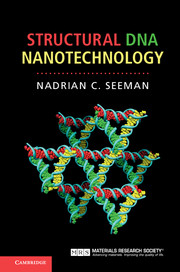Book contents
- Frontmatter
- Contents
- Preface
- 1 The origin of structural DNA nanotechnology
- 2 The design of DNA sequences for branched systems
- 3 Motif design based on reciprocal exchange
- 4 Single-stranded DNA topology and motif design
- 5 Experimental techniques
- 6 A short historical interlude: the search for robust DNA motifs
- 7 Combining DNA motifs into larger multi-component constructs
- 8 DNA nanomechanical devices
- 9 DNA origami and DNA bricks
- 10 Combining structure and motion
- 11 Self-replicating systems
- 12 Computing with DNA
- 13 Not just plain vanilla DNA nanotechnology: other pairings, other backbones
- 14 DNA nanotechnology organizing other materials
- Afterword
- Index
- References
13 - Not just plain vanilla DNA nanotechnology: other pairings, other backbones
Published online by Cambridge University Press: 05 December 2015
- Frontmatter
- Contents
- Preface
- 1 The origin of structural DNA nanotechnology
- 2 The design of DNA sequences for branched systems
- 3 Motif design based on reciprocal exchange
- 4 Single-stranded DNA topology and motif design
- 5 Experimental techniques
- 6 A short historical interlude: the search for robust DNA motifs
- 7 Combining DNA motifs into larger multi-component constructs
- 8 DNA nanomechanical devices
- 9 DNA origami and DNA bricks
- 10 Combining structure and motion
- 11 Self-replicating systems
- 12 Computing with DNA
- 13 Not just plain vanilla DNA nanotechnology: other pairings, other backbones
- 14 DNA nanotechnology organizing other materials
- Afterword
- Index
- References
Summary
Up to this point, we have been talking largely about Watson–Crick double helical DNA. No variations in the base-pairing and no variations in the backbone. Here we are going to discuss just a little bit of the work that is going on with other DNA structures, work that entails non-DNA backbones, and other species organized by DNA nanoconstructs. This chapter is not meant to be a comprehensive review of variations on the theme of either DNA nor its interactions with other species, just a taste to stimulate the reader to pursue other materials on her own.
Paukstelis DNA structure. Perhaps the first place to start is DNA, but DNA that is not simply Watson–Crick. A robust motif discovered in a single-crystal structure is shown in Figure 13-1. This motif contains three conventional nucleotide pairs and three parallel pairs, consisting of one A–G pair and two G–G pairs. This overall motif is shown in stereo in Figure 13-2. A salient feature of the structure is that it crystallizes in a hexagonal space group with a cavity whose volume is 300 Å3, which is shown in stereo in Figure 13-3a. The robustness of the motif is demonstrated by the fact that the Watson–Crick portion of the motif can be extended by 10 nucleotide pairs, yet the space group remains the same. Although the resolution of the crystal decreases somewhat, the cavity is greatly expanded by this expansion, so its volume is now increased markedly, as shown in Figure 13-3b.
Triplex DNA. In addition to the simple double helical motif, there are other helical motifs that have been characterized. The earliest of these was the DNA triplex, wherein a pyrimidine–purine–pyrimidine structure was formed (see Figures 2-4 and 2-5). There are a number of utilities that one can imagine for such systems in DNA constructs. Without disrupting the double helix, it is possible to address specifically designed locations within the assembly by adding a triplex-forming oligonucleotide (TFO). One could imagine tethering both small molecules and macromolecules to DNA constructs by the use of triplex associations. An example of triplex DNA added to DNA tensegrity-triangle crystals (see Chapter 7, especially Figure 7-23) is shown schematically in Figure 13-4; crystals to which triplex molecules containing dyes have been attached are shown in Figure 13-5.
- Type
- Chapter
- Information
- Structural DNA Nanotechnology , pp. 213 - 230Publisher: Cambridge University PressPrint publication year: 2016



